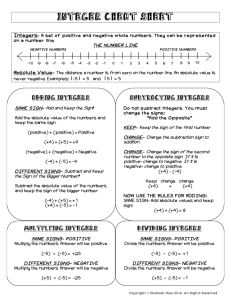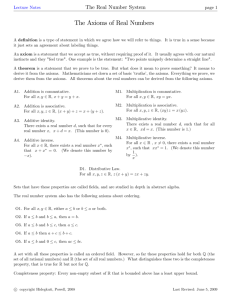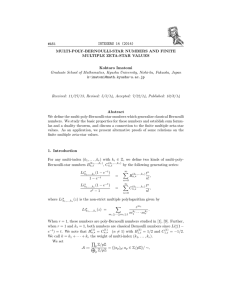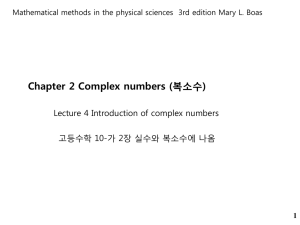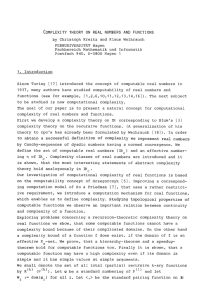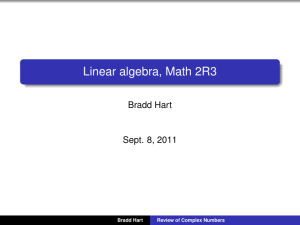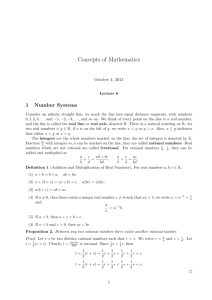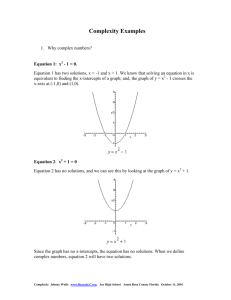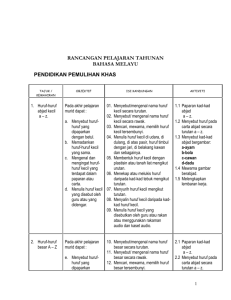Review of Basic Concepts - University of Rochester Mathematics
advertisement
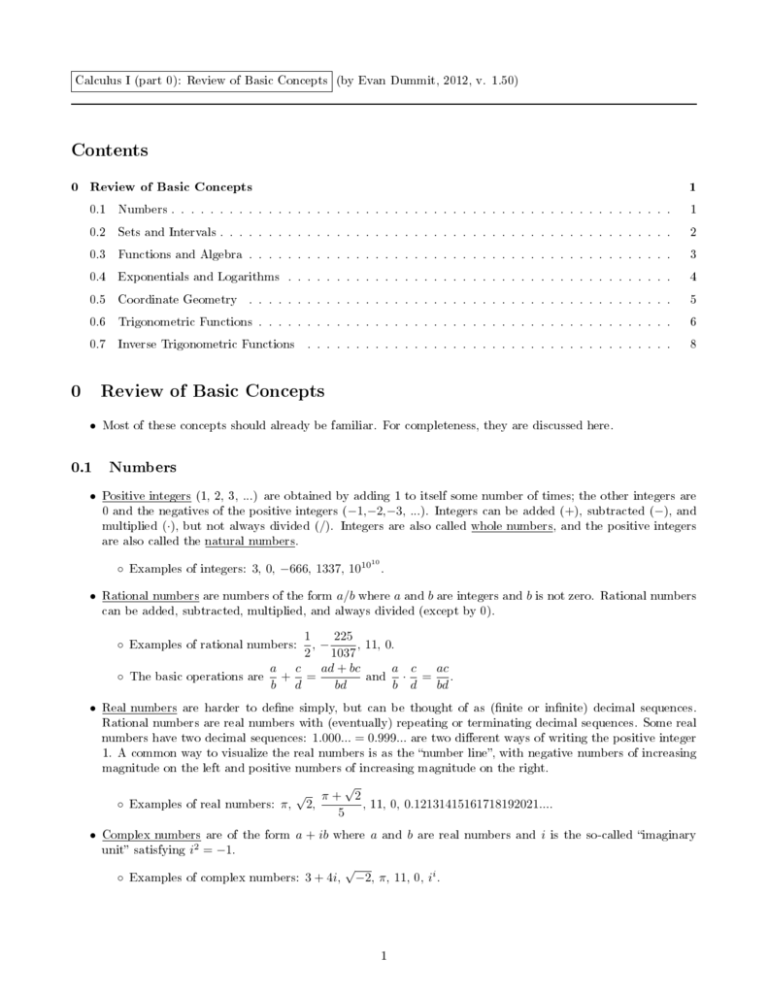
Calculus I (part 0): Review of Basic Concepts
(by Evan Dummit, 2012, v. 1.50)
Contents
0 Review of Basic Concepts
1
0.1
Numbers . . . . . . . . . . . . . . . . . . . . . . . . . . . . . . . . . . . . . . . . . . . . . . . . . . . .
1
0.2
Sets and Intervals . . . . . . . . . . . . . . . . . . . . . . . . . . . . . . . . . . . . . . . . . . . . . . .
2
0.3
Functions and Algebra . . . . . . . . . . . . . . . . . . . . . . . . . . . . . . . . . . . . . . . . . . . .
3
0.4
Exponentials and Logarithms . . . . . . . . . . . . . . . . . . . . . . . . . . . . . . . . . . . . . . . .
4
0.5
Coordinate Geometry
. . . . . . . . . . . . . . . . . . . . . . . . . . . . . . . . . . . . . . . . . . . .
5
0.6
Trigonometric Functions . . . . . . . . . . . . . . . . . . . . . . . . . . . . . . . . . . . . . . . . . . .
6
0.7
Inverse Trigonometric Functions
8
0
. . . . . . . . . . . . . . . . . . . . . . . . . . . . . . . . . . . . . .
Review of Basic Concepts
•
0.1
•
Most of these concepts should already be familiar. For completeness, they are discussed here.
Numbers
Positive integers (1, 2, 3, ...) are obtained by adding 1 to itself some number of times; the other integers are
0 and the negatives of the positive integers (−1,−2,−3, ...). Integers can be added (+), subtracted (−), and
multiplied
(·),
but not always divided (/). Integers are also called whole numbers, and the positive integers
are also called the natural numbers.
◦
•
Examples of integers:
10
3, 0, −666, 1337, 1010
Rational numbers are numbers of the form
.
a/b where a and b are integers and b is not zero.
Rational numbers
can be added, subtracted, multiplied, and always divided (except by 0).
•
1
225
, −
, 11, 0.
2
1037
a
c
ad + bc
a c
ac
+ =
and
· = .
b
d
bd
b d
bd
◦
Examples of rational numbers:
◦
The basic operations are
Real numbers are harder to dene simply, but can be thought of as (nite or innite) decimal sequences.
Rational numbers are real numbers with (eventually) repeating or terminating decimal sequences. Some real
numbers have two decimal sequences:
1.000... = 0.999...
are two dierent ways of writing the positive integer
1. A common way to visualize the real numbers is as the number line, with negative numbers of increasing
magnitude on the left and positive numbers of increasing magnitude on the right.
◦
•
Examples of real numbers:
π,
Complex numbers are of the form
unit satisfying
◦
√
√
π+ 2
2,
,
5
a + ib
where
11, 0,
a
and
0.12131415161718192021....
b
are real numbers and
i2 = −1.
Examples of complex numbers:
3 + 4i,
√
−2, π , 11,
1
0,
ii .
i
is the so-called imaginary
0.2
•
Sets and Intervals
Denition: A set is a well-dened collection of distinct elements.
◦
The elements of a set can be anything: integers, real numbers, other sets, people.
We are generally
interested in sets of real numbers.
◦
Sets are generally denoted by capital or script letters, and when listing the elements of a set, curly
{·}
brackets
are used.
◦
Sets do not have to have any elements: the empty set
∅={}
◦
Two sets are the same precisely if all of their elements are the same. The elements in a set are also not
is the set with no elements at all.
ordered, and no element can appear in a set more than once: thus the sets
•
{1, 4} and {4, 1} are the same.
There are two primary ways to dene a set.
◦
One way is to list all the elements: for example,
A = {1, 2, 4, 5}
is the set containing the four numbers
1, 2, 4, and 5.
◦
The other way to dene a set is to describe properties of its elements: for example, the set
words in the English alphabet has two elements:
◦
S
of one-letter
S = {a, I}.
Obligatory pedantic remark: It is possible to run into trouble by trying to dene sets in this naive way
of specifying qualities of their elements. In general, one must be more careful when dening arbitrary
sets, although we will not generally have to worry about this.
•
We often employ set-builder notation for sets: for example, the set
denoted
◦
•
•
|
S
of real numbers between 0 and 5 is
0 ≤ x ≤ 5}.
:
instead of a colon
but this distinction is irrelevant.
Sets of common types of numbers come up very often, and are given special symbols:
◦
The set
{1, 2, 3, ...}
◦
The set
{..., −2, −1, 0, 1, 2, ...}
◦
The set of all rational numbers is denoted
◦
The set of all real numbers is denoted
◦
The set of all complex numbers is denoted
of all natural numbers is denoted
N
of all integers is denoted
R
Q
(naturals).
Zahlen, German for numbers).
(
Z
(quotients).
(reals).
C
(complex).
There is additional (interval) notation for subsets of the real numbers. For real numbers
◦
The closed interval
◦
The open interval
◦
The half-open interval
(a, b]
denotes the set of real numbers satisfying
a < x ≤ b.
◦
The half-open interval
[a, b)
denotes the set of real numbers satisfying
a ≤ x < b.
◦
The notation
[a, ∞)
◦
The notation
(−∞, b]
◦
(a, b)
denotes the set of real numbers
denotes the set of real numbers
denotes the set of real numbers
x
denotes the set of real numbers
x
x
satisfying
satisfying
satisfying
x
with
a < b:
a ≤ x ≤ b.
a < x < b.
a ≤ x.
satisfying
x ≤ b.
Note that
The notation
S
∞
and
−∞
(−∞, ∞)
is a set,
x∈S
are not real numbers: they are just suggestive pieces of notation.
denotes the set of all real numbers.
means x is an element of
S , and the notation x 6∈ S
means x is not an element
S .
◦
Example: For
Denition: If
A
[a, b]
a, b
There are also open versions (with a round bracket) which do not include the nite endpoint.
Notation: If
of
•
is a real number and
Some authors use a vertical pipe
∗
∗
•
S = {x : x
A
is a subset of
S = {1, 2, 5}
and
B
B
we have
1∈S
and
5∈S
but
3 6∈ S
and
π 6∈ S .
are two sets with the property that every element of
(or that
A
is contained in
B)
and write
2
A ⊆ B.
A
is also an element of
B,
we say
◦
◦
B
A
is a subset of
The dierence is not terribly relevant except for when
B
subset of
Denition: If
A
and
◦
0.3
•
then
B.
A⊆C
and
B⊆C
but neither
A
A
A
could be equal to
which cannot be all of
and
The union
Example: If
A⊂B
is also commonly used to say
B.
to include the possibility that
•
C = {1, 2, 3, 4, 5},
and
is a subset of the other.
Note: Subset notation is not universally agreed-upon: the notation
that
◦
A = {1, 2, 3}, B = {1, 4, 5},
Example: If
nor
B,
A
can be equal to
B:
some authors allow
while others insist that
A⊂B
means that
B.
B are two sets, then the intersection A ∩ B is the set of all elements contained
A ∪ B is the set of all elements contained in either A or B (or both).
A = {1, 2, 3}
and
A⊂B
A is a
B = {1, 4, 5},
then
A ∩ B = {1}
and
in both
A ∪ B = {1, 2, 3, 4, 5}.
Functions and Algebra
A function is a relation between a set of inputs (called the domain of the function) and a set of outputs (called
the range of the function): for each element of the domain, the function outputs a single value in the range.
•
Example:
f (x) = x3 ,
with domain and range both the set of real numbers. This function
x
to its cube
x3 .
number
◦
f
sends each real
We will usually work with functions whose domain and range are (subsets of ) the real numbers. But
functions can be dened with any arbitrary domain and range.
•
Two functions
f
◦
•
g
and
second. Applying
f
Example: Let
can be composed, provided the range of the rst is a subset of the domain of the
and then
f (x) = x2
g
to
and
x
is denoted
f (g(x)) = (f ◦ g)(x).
g(x) = 2x + 1.
Find
f ◦g
and
g ◦ f.
(f ◦ g)(x) = f (g(x)) = f (2x + 1) = (2x + 1)2 = 4x2 + 4x + 1
∗
We have
∗
Meanwhile,
(g ◦ f )(x) = g(f (x)) = g(x2 ) = 2x2 + 1
.
◦
In the example above, notice that the composition depends on the order.
◦
In general, it will be the case that
Denition: A function
f (a) 6= f (b)
f
f ◦g
and
g◦f
is one-to-one (or injective) if
in other words,
f
are
.
completely unrelated
f (a) = f (b)
implies
a = b,
functions!
or equivalently, if
a 6= b
then
is one-to-one if unequal elements in the domain are sent to unequal elements
in the range.
◦
For functions whose domain and range are the real numbers, one-to-one functions satisfy the horizontal
line test: a horizontal line will intersect the graph of the function at most once.
•
f (x) has an inverse function f −1 (x) dened
f (f (y)) = y for every y in the range of f .
A one-to-one function
domain of
◦
f,
and
so that
f −1 (f (x)) = x
for every
x
in the
−1
Example: The function
f (x) = x3 ,
which (it can be checked) is one-to-one, has inverse
f −1 (x) =
√
3
x=
x1/3 .
•
A function which is not one-to-one does not have a well-dened inverse function, because there will be an
ambiguity somewhere: such a function must send two values in its domain to the same point in its range but then this causes diculties if we attempt to dene an inverse function.
◦
The way to get around this ambiguity problem is to narrow the domain of the function: if we restrict
the domain so as to make the new restricted function one-to-one on the smaller domain, we can dene
an inverse function on that restricted domain.
•
Example: Consider trying to dene an inverse function for the function
x.
3
f (x) = x2
dened for all real numbers
◦
4,
◦
f (2) = 22 = 4, and so f −1 should have f −1 (4) = 2. But it is also the case that f (−2) = (−2)2 =
−1
so we should also have f
(4) = −2. This is a problem: f −1 (4) cannot have two dierent values.
We have
and
We can get around this problem by restricting the domain of
g(x) = x2
dened only for
x ≥ 0,
then
g
f.
Specically, if we work with the function
g −1 (x) =
does have an inverse, namely
√
x = x1/2 :
we have
removed the troublesome negative numbers from the domain.
•
0.4
•
We make a few miscellaneous remarks about basic properties of algebra:
(a + b)2 = a2 + 2ab + b2
◦
Some common identities are
◦
The quadratic formula says that the roots of
a2 − b2 = (a + b)(a − b).
√
−b ± b2 − 4ac
2
ax + bx + c = 0 are x =
.
2a
and
Exponentials and Logarithms
Denition: The exponential function
a positive integer,
an
ax
for
a>0
n is
a2 = a · a, a3 = a · a · a,
is motivated by the idea of repeated multiplication: if
is dened to be the result of multiplying
a by itself n times:
thus
and so forth.
◦
◦
√
q
For fractional powers,
a = a1/q
is dened to be the (nonnegative) real number whose
We can then dene the exponential with any fractional exponent
a−b
p/q
a
to be
1/q p
(a
)
q th
power is
a.
.
1
= b.
a
◦
For negative powers, we also set
◦
Examples: We have
◦
For arbitrary real number exponents, we must resort to a limiting procedure. (We will omit the details.)
◦
Integer powers of negative numbers (e.g.,
◦ 0b
◦
24 = 16
is zero for positive
b
,
√
3
125 = 5
, and
16−3/4 =
(−2)3 = −8)
and is undened for other
Non-integer powers of negative numbers (e.g.,
1
3
161/4
=
1
1
=
23
8
.
are dened using repeated multiplication.
b.
(−2)−1/2 )
are not real numbers: the expressions can be
given meaning using complex numbers, although there is some amount of ambiguity involved.
•
In general, exponentials possess the following properties:
◦ ab ac = ab+c
◦ (a1 )b (a2 )b = (a1 a2 )b
c
◦ ab = abc
1
◦ a−b = b
a
◦
•
(x2/3 y 3/4 )2 · (xy)−1 = x4/3 y 3/2 · x−1 y −1 = x1/3 y 1/2
Denition: The general base-b logarithm
thus,
◦
•
Example: We have
y = logb x
Example:
is equivalent to saying
log5 125 = 3
For any positive
b, x, y
with
, since
b 6= 1,
logb x is dened
y
that x = b .
125 = 53 ,
and
log3
√
.
to be the inverse function of the exponential
27 =
3
2
, since
√
27 =
the following properties hold:
◦ logb [xy] = logb x + logb y
◦ logb [xa ] = a logb x
◦ loga b · logb c = loga c.
◦
Example:
log10 (x4 y 3 ) = log10 (x4 ) + log10 (y 3 ) = 4 log10 (x) + 3 log10 (y)
4
.
√
33 = 33/2 .
bx :
•
•
Example: Solve the equation
73x+4 = 3
for
x.
◦
We take the logarithm to the base 7 of both sides:
◦
Since the logarithm and exponential are inverses,
◦
Thus,
3x + 4 = log7 (3),
The natural logarithm
◦
ln(x)
so
x=
log7 (3) − 4
3
is equal to
loge (x),
log7 (73x+4 ) = log7 (3).
log7 (73x+4 ) = 3x + 4.
.
whose base is the number
e ≈ 2.718.
The choice of this somewhat-strange number as our logarithm base seems arbitrary. In fact, this logarithm
base, as we will see later, is by far the most natural choice for the purposes of calculus.
◦
•
In general, all logarithms can be expressed in terms of the natural logarithm:
Logarithms of negative numbers and logarithms with a negative base, such as
loga b =
ln(b)
.
ln(a)
ln(−1) and log−2 5,
are not real
numbers.
◦
These expressions can be given meaning using complex numbers, although there is some amount of
ambiguity involved.
0.5
•
Coordinate Geometry
We can graphically represent functions using coordinate geometry: if
function by drawing all of the points
◦
Recall that the point
(x, y)
(x, f (x))
f (x)
is a function, we can graph the
in the plane.
denotes the point which is a horizontal distance
x
and a vertical distance
y
from the origin (0,0).
◦
using more general relations, like
•
y = f (x), though we
3x + 2y = 5, or x2 + y 2 = 1.
We usually describe a graph in the form
can also describe the points on a graph
The most basic graph is a line, whose most general equation has the form
ax + by = d
for some constants
a, b, d.
y2 − y1
.
x2 − x1
◦
A line passing through the two points
◦
The slope of a horizontal line is 0, and the slope of a vertical line is undened (though it is often taken
to be
(x1 , y1 )
and
(x2 , y2 )
has slope
m=
∞).
◦
Two lines are parallel if their slopes are equal.
◦
Two lines are perpendicular if their slopes have product
−1
(where we interpret
0 · ∞ = −1
in this
setting).
•
•
There are two other common forms for the equation for a line:
◦
Slope-intercept form:
◦
Point-slope form:
◦
Note that neither of these two forms can describe a vertical line, which has the special form
y = mx + b,
where
y − y0 = m(x − x0 ),
m
is the slope and
where
Example: Find an equation for the line through
m
b
is the slope and
(1, 4)
and
(3, 7).
◦
To describe a line, we need a point on the line, and the slope.
◦
The slope is
◦
Hence, an equation in point-slope form is
m=
7−4
3
= ,
3−1
2
and a point on the line is
y−4=
5
is the
(1, 4).
3
(x − 1)
2
.
y -intercept.
(x0 , y0 )
is any point on the line.
x = a.
◦
•
•
Example: Find an equation for the line through
◦
The line
◦
Hence the desired line has slope
◦
Using point-slope, we obtain the equation
3x − 2y = 7
3
7
x− ,
2
2
2
−1
=− .
3/2
3
2
y − 5 = − (x − 2)
3
3/2.
.
(x − h)2 + (y − k)2 = r2 where (h, k)
r is πr2 and the circumference is 2πr.
The general equation of a circle is
(h, k),
is
a
b
and
is the radius.
a2 + b2 = c2 .
√
1 − 3 − 2, and the 3 − 4 − 5.
c
and hypotenuse
Distance Formula: The distance between
(x1 , y1 )
and
◦
This is simply an application of the Pythagorean Theorem.
◦
Example: The distance between
(1, 2)
and
(4, 3)
has
√
1 − 1 − 2, the
p
(x2 , y2 ) is (x2 − x1 )2 + (y2 − y1 )2 .
Three right triangles that show up frequently are the
is
p
(4 − 1)2 + (3 − 2)2 =
√
10
.
Trigonometric Functions
First, we remark that we always measure angles in radians: a right angle is
radians.
•
r
a and b are parallel to the x and y axes,
(y − k)2
(x − h)2
+
= 1. The area of this ellipse is πab.
a2
b2
Pythagorean Theorem: A right triangle with legs
◦
is the center and
A general form for equation of an ellipse whose axes of lengths
respectively, and whose center is
•
which has slope
3x − 2y = 7.
Two other common graphs are circles and ellipses:
◦
0.6
y=
is the same as
.
perpendicular to the line
To describe a line, we need a point on the line, and the slope.
The area of this circle of radius
•
(2, 5)
3
5
x+
2
2
◦
◦
•
y=
We could also put this in slope-intercept form as
π
2
radians, and a full circle is
2π
The three basic trigonometric functions are sine, cosine, and tangent.
opposite
◦
In a right triangle with an acute angle
◦
If one draws a ray from the origin making an angle
unit circle
◦
x2 + y 2 = 1
at the point
θ, sin(θ) =
hypotenuse
θ
,
cos(θ) =
with the positive
adjacent
hypotenuse
x-axis,
,
tan(θ) =
opposite
adjacent
.
the ray will intersect the
(cos(θ), sin(θ)).
Here are the graphs of sine, cosine, and tangent (respectively):
1.0
1.0
6
4
0.5
0.5
2
-6
-4
-2
2
4
6
-6
-4
-2
2
4
6
-3
-2
-1
1
2
3
-2
-0.5
-0.5
-1.0
-1.0
-4
◦
The ranges of sine and cosine are
◦
Sine and tangent are odd functions, meaning that
is an even function, meaning that
◦
•
-6
[−1, 1]
and the range of tangent is
(−∞, ∞).
sin(θ) = − sin(−θ)
cos(θ) = cos(−θ).
Sine and cosine are periodic with period
2π .
Tangent has period
and similarly for tangent. Cosine
π.
There are three other trigonometric functions that are used (though less frequently): secant, cosecant, cotangent.
6
1
1
, csc(θ) =
,
cos(θ)
sin(θ)
1
.
tan(θ)
◦
They are dened as
◦
Here are the graphs of secant, cosecant, and cotangent (respectively):
sec(θ) =
and
cot(θ) =
6
6
5
4
4
2
2
-6
-4
-2
2
4
-6
6
-4
-2
2
4
-3
6
-2
-1
1
-2
2
3
-2
-4
-4
-5
-6
-6
•
◦
Cosecant and cotangent are odd functions, and secant is an even function.
◦
Secant and cosecant have period
2π .
Cotangent has period
π.
There are a number of special angles, where the values of the trigonometric functions are easy to calculate
using geometry.
θ
sin(θ)
cos(θ)
tan(θ)
◦
0
0
1
0
π/6
√1/2
3/2
√
1/ 3
√π/4
√2/2
2/2
√π/3
3/2
1/2
√
3
1
π/2
1
0
undef.
2π/3
√
3/2
−1/2
√
− 3
3π/4
√
√2/2
− 2/2
−1
5π/6
1/2
√
− 3/2
√
−1/ 3
π
0
−1
0
Using the table above and the periodicity and even/odd relations, one can nd sines, cosines, and tangents
of other angles.
√
◦
•
sin(11π/3) = − sin(π/3) = −
◦
Addition formula for sine:
, and
cos(11π/6) = cos(π/6) =
1
2
.
◦
Addition formula for cosine:
Pythagorean identity:
sin(φ + θ) = sin(φ) cos(θ) + cos(φ) sin(θ).
cos(φ + θ) = cos(φ) cos(θ) − sin(φ) sin(θ).
2
sin (θ) + cos2 (θ) = 1.
Using the results above, one can obtain a number of others, such as the following:
◦
Addition formula for tangent:
◦
Double-angle formulas:
tan(φ + θ) =
sin(2θ)
=
cos(2θ)
=
tan(2θ)
◦
•
3
2
There are many trigonometric identities, the most important of which are the following three:
◦
•
For example,
tan(φ) + tan(θ)
.
1 − tan(φ) tan(θ)
2 sin(θ) cos(θ)
cos2 (θ) − sin2 (θ) = 2 cos2 (θ) − 1 = 1 − 2 sin2 (θ)
2 tan(θ)
=
1 − tan2 (θ)
(Other) Pythagorean identities:
tan2 (θ) + 1 = sec2 (θ), 1 + cot2 (θ) = csc2 (θ).
There are also two results that relate angle measurements to side lengths in general triangles:
◦
Law of sines: In triangle ABC,
c=
◦
length of
a
b
c
=
=
,
sin(A)
sin(B)
sin(C)
where
a
= length of
BC , b =
length of
AB .
Law of cosines: In triangle ABC,
c2 = a2 + b2 − 2ab cos(C),
7
where
a
= length of
BC ,
etc.
AC ,
0.7
•
Inverse Trigonometric Functions
None of the six standard trigonometric functions is one-to-one.
◦
•
To dene inverse functions, the domains are rst restricted to an interval where the function is one-to-one.
Here are the standard denitions for arcsine, arccosine, and arctangent:
h π πi
sin−1 (x) is the inverse function of sin(x) on the interval − , . Its domain is [−1, 1] and its
2 2
h π πi
range is − ,
.
2 2
◦ Arccosine: cos−1 (x) is the inverse function of cos(x) on the interval [0, π]. Its domain is [−1, 1] and its
range is [0, π] .
π π
. Its domain is (−∞, ∞)
◦ Arctangent: tan−1 (x) is the inverse function of tan(x) on the interval − ,
2 2
h π πi
and its range is − ,
.
2 2
◦ Here are the graphs of arcsine, arccosine, and arctangent (respectively):
◦
Arcsine:
1.5
1.0
0.5
3.0
1.5
2.5
1.0
2.0
0.5
1.5
-1.0
-0.5
0.5
-10
1.0
-1.5
-1.0
5
10
-0.5
0.5
-1.0
•
-5
1.0
-0.5
-1.0
-0.5
0.5
-1.5
1.0
We can compute some basic values using the denition: for example,
sin−1 (1/2) =
π
6
, from the list of special
angles. We can nd some others using geometry.
•
Example: Find the exact value of
◦
If
θ = tan−1 (4/3),
then
θ
cos(tan−1 (4/3)).
is the acute in a right triangle where the opposite side has length 4 and the
adjacent side has length 3.
•
cos(tan−1 (4/3)) = cos(θ) =
adjacent
◦
Then
◦
The Pythagorean Theorem says that the hypotenuse has length
hypotenuse
, in this triangle.
√
32 + 42 = 5, so we see that cos(θ) =
3
5
.
For the other three functions, there is some disagreement about the proper domain. We will not make much
use of these, but here are the denitions (merely for the record):
π π
and
,π .
0,
2 π 2 π
◦ Arccosecant: csc−1 (x) is the inverse function of csc(x) on − , 0 and 0,
.
2
2
◦ Arccotangent: cot−1 (x) is the inverse function of cot(x) on the interval (0, π).
◦ Here are the graphs of arcsecant, arccosecant, and arccotangent (respectively):
◦
Arcsecant:
sec−1 (x)
is the inverse function of
3.0
sec(x)
on
3.0
1.5
2.5
2.5
1.0
2.0
2.0
0.5
1.5
1.5
-5
1.0
1.0
-0.5
0.5
-5
5
0.5
-1.0
0
5
-1.5
-5
5
Well, you're at the end of my handout. Hope it was helpful.
Copyright notice: This material is copyright Evan Dummit, 2012. You may not reproduce or distribute this material
without my express permission.
8
